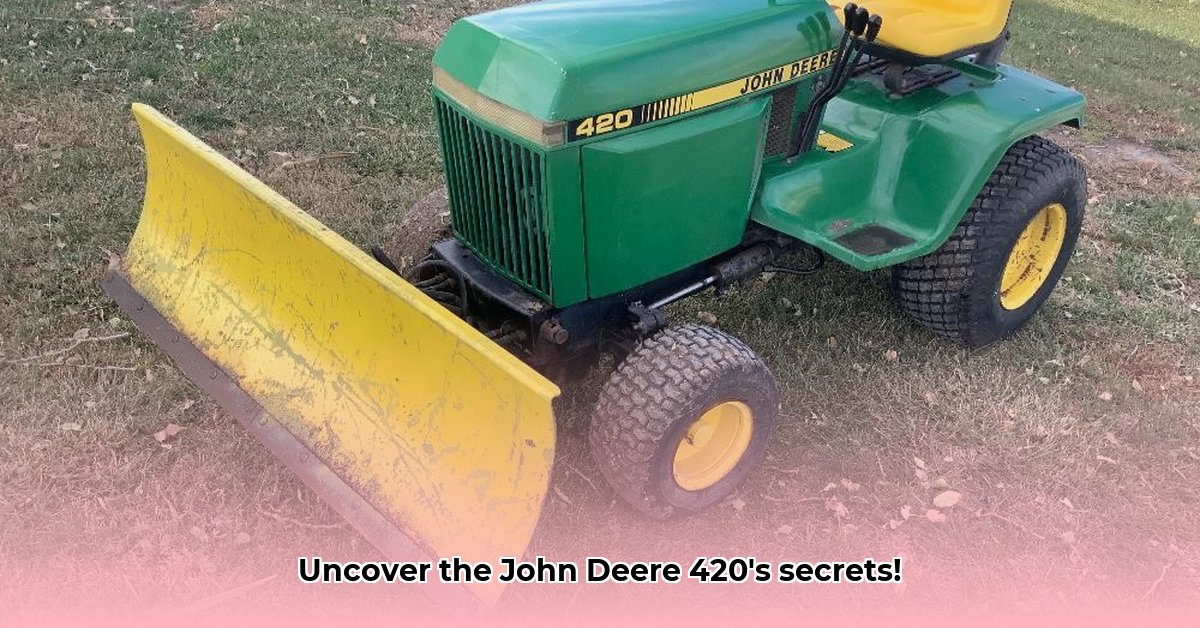
A Retrospective on the John Deere 420 Garden Tractor
The John Deere 420 garden tractor, manufactured from 1983 to 1991, remains a popular topic among enthusiasts and collectors. This model, produced in Horicon, Wisconsin, offered a compelling blend of power and versatility for its time, appealing to both homeowners and small-scale farmers. But how well does it hold up against the scrutiny of modern standards, and what is its lasting legacy? Let's delve into the details. For more information, see this helpful John Deere 420 resource.
Under the Hood: Powertrain Specifications
The John Deere 420's power source was a 20-horsepower Onan B48G/P220G engine (a reliable engine known for its durability in various machines of the era). This provided sufficient power for typical residential and light agricultural tasks like mowing, snow removal, and light grading. While not a heavy-duty workhorse, its performance was adequate for its intended use. Was it the most powerful engine available? No, but it offered sufficient power for its intended applications.
Detailed Specifications: A Comparative Analysis
Sources provide slightly different specifications for the 420, highlighting the challenges of obtaining precise data for older equipment. Below is a summary of the available information, with discrepancies noted:
| Specification | Source A | Source B | Notes |
|---|---|---|---|
| Manufacturing Years | 1983-1991 | 1983-1991 | Consistent across sources. |
| Engine | Onan B48G/P220G | Onan B48G/P220G | A reliable and common engine for its time. |
| Horsepower | 20 HP | 20 HP | Sufficient for typical home and small farm tasks. |
| Fuel Tank Capacity | 6.5 gal (24.6 L) | 25 L | Discrepancy requires further verification. |
| Weight | 993 lbs (450 kg) | 899 lbs (408 kg) | Significant difference; additional research needed to confirm the correct weight. |
| Production Location | Horicon, WI | Horicon, WI | Made in the United States. |
The variations in fuel tank capacity and weight highlight the need for further research, potentially consulting John Deere archives or owner's manuals.
Versatility and Attachments: Expanding Capabilities
The John Deere 420's adaptability was a key selling point. The tractor was not limited to mowing; it accommodated various attachments, including 50-inch and 60-inch mower decks, snow blowers, blades for grading, and even front-end loaders. This versatility significantly broadened its usefulness. How many attachments were available? A wide selection increased its appeal to a range of users.
Parts Availability and Maintenance: A Collector's Perspective
Finding original manuals and technical documents is often achievable through online resources and collector communities. However, acquiring replacement parts might prove more challenging due to age and discontinued production. Many enthusiasts actively seek and share such information, facilitating the maintenance and restoration of these iconic machines. What's the current state of parts availability? A mixed bag, requiring proactive searching and community involvement.
Stakeholder Impact and Legacy: A Lasting Impression
The John Deere 420 holds a special place for several groups:
- Enthusiasts and Collectors: These individuals value the 420's historical significance and sturdy build. Their restoration efforts help preserve a piece of agricultural history.
- Small-scale Farmers and Landowners: Some still utilize the 420 for light tasks, emphasizing its ease of maintenance and repair.
- Parts Suppliers: The ongoing demand for parts supports a niche market catering to this segment of collectors and users.
How has the John Deere 420 impacted its stakeholders? It provides a tangible link to the past while also supporting a small but dedicated community.
Restoration Guide: A Step-by-Step Approach
Restoring a John Deere 420 can be a rewarding but challenging project:
- Assessment: Evaluate the tractor’s condition comprehensively.
- Parts Gathering: Secure necessary parts, leveraging online communities (1) for leads.
- Disassembly: Meticulously dismantle the tractor, documenting each step.
- Rust Repair & Bodywork: Address rust and repaint as needed.
- Mechanical Restoration: Clean, repair or replace mechanical components.
- Reassembly: Reassemble carefully, verifying each connection.
- Testing & Fine-Tuning: Perform a test run and address any remaining issues.
This restoration process demands mechanical aptitude and patience.
Conclusion: The Enduring Appeal of the John Deere 420
The John Deere 420, despite its age, retains a strong presence within the collector and enthusiast communities. Its enduring appeal stems from a combination of factors: its robust design, versatility, and the sense of nostalgia it evokes. While modern alternatives may offer enhanced performance, the 420's legacy rests firmly on its historical significance and the active community that continues to cherish and maintain these machines. The challenges of parts availability and the labor-intensive nature of restoration are counterbalanced by the personal satisfaction and tangible link to a bygone era of agricultural engineering.